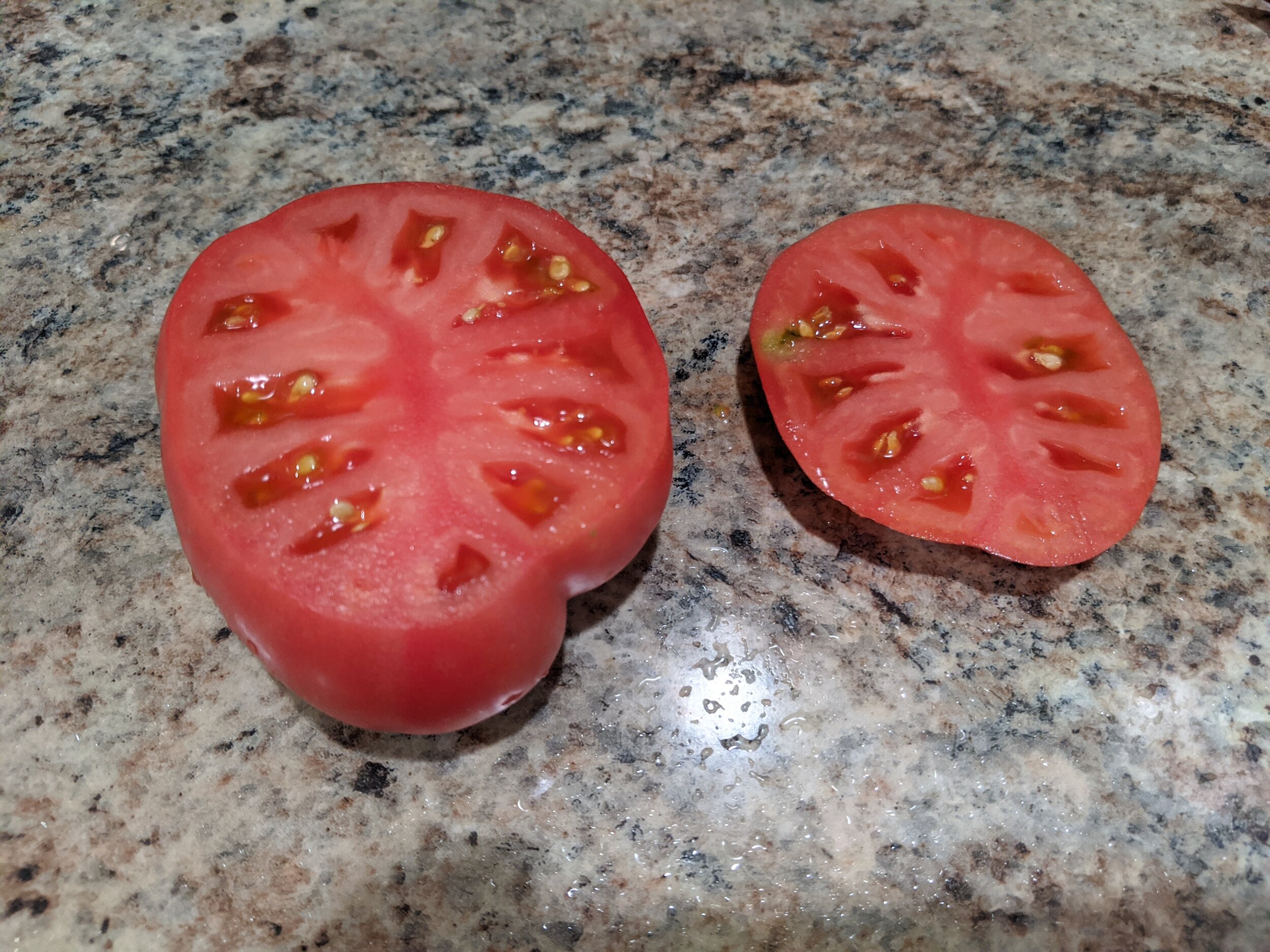The red bud is on the cusp!
It was a pretty damp day, but mild, which made it perfect to continue the transplanting process. In yesterday’s blog, I began reporting on my germination results. Below is the data collected today.
Indeterminate varieties
Green Giant T20-20 - 100%, all potato leaf
Lucky Cross T20-4 - 91%, 20 potato leaf, 1 regular leaf
Little Lucky T20-18 - 100%, but 8 regular leaf, 14 expected potato leaf.
Sungold (hybrid, new seed, from Johnny’s) - 100%
Egg Yolk T20-126 - 100%
Mexico Midget T19-144 - 80%
Red Brandywine T18-11 - 100%
Nepal 6585 (from my friend Charlie) - 100%
Don’s Double Delight T20-1 - 90%
Cancelmo Family Heirloom T20-15 - 100%
Dester T20-3 - 44%
Speckled Roman T12-68 - 72%
Blue’s Bling T20-24 - 96%
Black Cherry T20-127 - 100%
Fruit T20-125 - 100%
Peak of Perfection T20-9 - 48%
Anna Russian T14-2 - 95%
Dr. Wyche’s Yellow T15-75 - 27%
Druzba T15-77 - 100%
Yellow Oxheart T13-16 - 100%
Ester’s Mortgage Lifter 7203 - 100%
Hugh’s T14-27 - 100%
Abraham Lincoln T19-113 - 100%
Magnus T15-52 - 67%
Giant Syrian T13-138 - 100%
Kellogg’s Breakfast T12-74 - 60%
Of all of the indeterminate varieties I’ve transplanted so far, the big disappointments from 2020 saved seed are Brandywine T20-16 (16%), Polish T20-7 (36%), Dester T20-3 (44%), Peak of Perfection T20-9 (48%), and the high level of clear crosses (regular leaf seedlings) with Little Lucky. Ferris Wheel for whatever reason always seems to come out as a mix (some potato leaf, some dwarfs). Anyone who received seeds of the above from me can now match my results with theirs.
Dwarf varieties
Dwarf Tanager T20-37 - 80%
Dwarf Perfect Harmony T20-38 - 100%
Dwarf Strawberry Lemonade T20-39 - 100%
Dwarf Mr. Snow T20-40 - 75%
Dwarf Chocolate Lightning T20-41 - 45%
Rosella Purple T20-43 - 44%
Dwarf Hazy’s Dream T20-44 - 100%
Dwarf Wild Spudleaf T20-45 - 100%
Tasmanian Chocolate T20-46 - 40%
Summertime Green T20-56 - 5%
Rosella Crimson T20-58 - 96%
Sweet Scarlet Dwarf T20-59 - 0%
Dwarf Golden Gypsy T20-60 - 100%
Dwarf Firebird Sweet T20-61 - 96%
Dwarf Beryl Beauty T20-66 - 100%
Dwarf Walter’s Fancy T20-79 - 100%
Dwarf Gloria’s Treat T20-95 - 100%
Dwarf Emerald Giant T20-96 - 100%
Dwarf Sweet Sue T20-97 - 43%
Capri Show Stopper 3499 - 33% (one seed of my last remaining 3 from Patrina - but it is dwarf!)
The big disappointments are Dwarf Sweet Sue, Tasmanian Chocolate, Dwarf Chocolate Lightning, Rosella Purple, and the dismal Summertime Green and Sweet Scarlet Dwarf. I’ve replanted all from different years of seed saving. I still suspect insufficiently dry seed before storing away.
Overall, I have to be really happy with results so far. Out of 40 indeterminate varieties, there were issues with only 4. And out of 20 dwarf varieties, 6 didn’t go well.
In my next transplant report, I hope to confirm leaf shape and plant habit with all of the new F1 hybrids (many of which were sent out to some of you to try. I will have results from replants of the failures from initial planting, and in a few weeks, results from an additional 20 dwarfs.
Aside from a few plantings of herbs and flowers and some tomatoes (the flat to be used as a demo for Joe’s filming for our course), the vast majority of my seed planting is done, and remarkably, lots of transplanting as well (up to 1000 seedlings!).
I hope those who received seeds from me find the data in this and the previous blog helpful.
One more bit of interesting information - days to germination vs years seeds saved.
2020 saved tomato seeds - the vast majority germinated in three days - with 3 types germinating in 2 days, 6 in 4 days, 2 in 6 days.
2019 saved seeds - 2 in 3 days, 1 in 4 days, 1 in 5 days
2018 saved seeds - 1 in 3 days
2015 saved seeds - 1 in 4 days, 2 in 5 days
2014 saved seeds - 2 in 4 days
2013 saved seeds - 1 in 4 days, 1 in 6 days
2012 saved seeds - 1 in 6 days
2009 saved seeds - weak germination in 14 days
2004 saved seeds - one variety, no germination
2003 saved seeds - no germination after 14 days for 3 varieties








































































